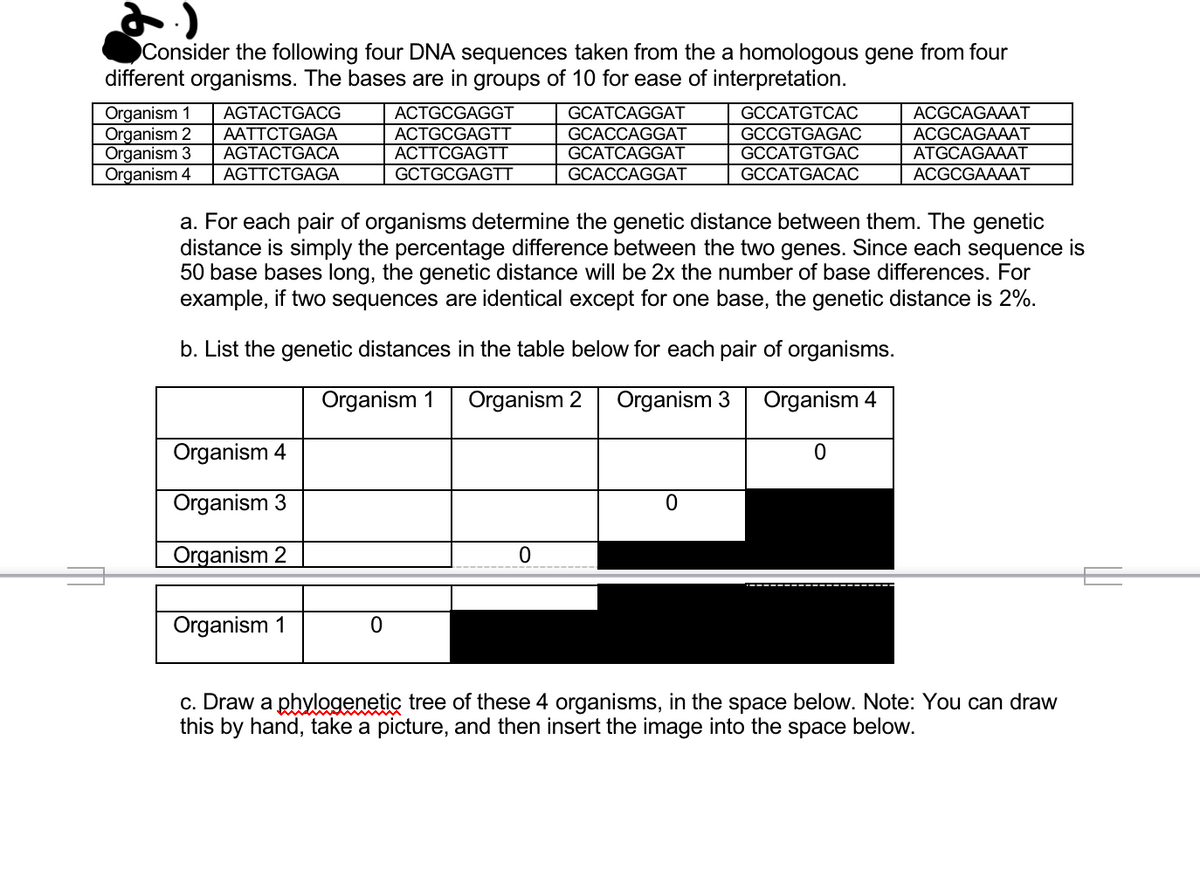Consider the following four DNA sequences taken from the a homologous gene from four different organisms. The bases are in groups of 10 for ease of interpretation. ACTGCGAGGT GCCATGTCAС АCGCAGAAAТ ACGCAGAAAT ATGCAGAAAT ACGCGAAAAT AGTACTGACG Organism 1 Organism 2 Organism 3 Organism 4 GCATCAGGAT ААТTСTGAGA AGTACTGACA AGTTCTGAGА ACTGCGAGTT ACTTCGAGTT GCTGCGAGTT GCACCAGGAT GCATCAGGAT GCACCAGGAT GCCGTGAGAC GCCATGTGAC GCCATGACAС a. For each pair of organisms determine the genetic distance between them. The genetic distance is simply the percentage difference between the two genes. Since each sequence is 50 base bases long, the genetic distance will be 2x the number of base differences. For example, if two sequences are identical except for one base, the genetic distance is 2%. b. List the genetic distances in the table below for each pair of organisms. Organism 1 Organism 2 Organism 3 Organism 4 Organism 4 Organism 3 Organism 2 Organism 1 c. Draw a phylogenetic tree of these 4 organisms, in the space below. Note: You can draw this by hand, take a picture, and then insert the image into the space below.
Consider the following four DNA sequences taken from the a homologous gene from four different organisms. The bases are in groups of 10 for ease of interpretation. ACTGCGAGGT GCCATGTCAС АCGCAGAAAТ ACGCAGAAAT ATGCAGAAAT ACGCGAAAAT AGTACTGACG Organism 1 Organism 2 Organism 3 Organism 4 GCATCAGGAT ААТTСTGAGA AGTACTGACA AGTTCTGAGА ACTGCGAGTT ACTTCGAGTT GCTGCGAGTT GCACCAGGAT GCATCAGGAT GCACCAGGAT GCCGTGAGAC GCCATGTGAC GCCATGACAС a. For each pair of organisms determine the genetic distance between them. The genetic distance is simply the percentage difference between the two genes. Since each sequence is 50 base bases long, the genetic distance will be 2x the number of base differences. For example, if two sequences are identical except for one base, the genetic distance is 2%. b. List the genetic distances in the table below for each pair of organisms. Organism 1 Organism 2 Organism 3 Organism 4 Organism 4 Organism 3 Organism 2 Organism 1 c. Draw a phylogenetic tree of these 4 organisms, in the space below. Note: You can draw this by hand, take a picture, and then insert the image into the space below.
Human Anatomy & Physiology (11th Edition)
11th Edition
ISBN:9780134580999
Author:Elaine N. Marieb, Katja N. Hoehn
Publisher:Elaine N. Marieb, Katja N. Hoehn
Chapter1: The Human Body: An Orientation
Section: Chapter Questions
Problem 1RQ: The correct sequence of levels forming the structural hierarchy is A. (a) organ, organ system,...
Related questions
Question

Transcribed Image Text:Consider the following four DNA sequences taken from the a homologous gene from four
different organisms. The bases are in groups of 10 for ease of interpretation.
ACTGCGAGGT
ACTGCGAGTT
ACTTCGAGTT
GCCATGTCAС
GCCGTGAGAC
GCCATGTGAC
AGTACTGACG
Organism 1
Organism 2
Organism 3
Organism 4
GCATCAGGAТ
GCACCAGGAT
GCATCAGGAT
ACGCAGAAAT
AATTCTGAGA
AGTACTGACA
AGTTCTGAGA
ACGCAGAAAT
ATGCAGAAAT
GCTGCGAGTT
GCACCAGGAT
GCCATGACÁC
ACGCGAAAAT
a. For each pair of organisms determine the genetic distance between them. The genetic
distance is simply the percentage difference between the two genes. Since each sequence is
50 base bases long, the genetic distance will be 2x the number of base differences. For
example, if two sequences are identical except for one base, the genetic distance is 2%.
b. List the genetic distances in the table below for each pair of organisms.
Organism 1
Organism 2
Organism 3
Organism 4
Organism 4
Organism 3
Organism 2
Organism 1
c. Draw a phylogenetic tree of these 4 organisms, in the space below. Note: You can draw
this by hand, take a picture, and then insert the image into the space below.
Expert Solution
This question has been solved!
Explore an expertly crafted, step-by-step solution for a thorough understanding of key concepts.
This is a popular solution!
Trending now
This is a popular solution!
Step by step
Solved in 4 steps with 8 images

Knowledge Booster
Learn more about
Need a deep-dive on the concept behind this application? Look no further. Learn more about this topic, biology and related others by exploring similar questions and additional content below.Recommended textbooks for you

Human Anatomy & Physiology (11th Edition)
Biology
ISBN:
9780134580999
Author:
Elaine N. Marieb, Katja N. Hoehn
Publisher:
PEARSON

Biology 2e
Biology
ISBN:
9781947172517
Author:
Matthew Douglas, Jung Choi, Mary Ann Clark
Publisher:
OpenStax

Anatomy & Physiology
Biology
ISBN:
9781259398629
Author:
McKinley, Michael P., O'loughlin, Valerie Dean, Bidle, Theresa Stouter
Publisher:
Mcgraw Hill Education,

Human Anatomy & Physiology (11th Edition)
Biology
ISBN:
9780134580999
Author:
Elaine N. Marieb, Katja N. Hoehn
Publisher:
PEARSON

Biology 2e
Biology
ISBN:
9781947172517
Author:
Matthew Douglas, Jung Choi, Mary Ann Clark
Publisher:
OpenStax

Anatomy & Physiology
Biology
ISBN:
9781259398629
Author:
McKinley, Michael P., O'loughlin, Valerie Dean, Bidle, Theresa Stouter
Publisher:
Mcgraw Hill Education,

Molecular Biology of the Cell (Sixth Edition)
Biology
ISBN:
9780815344322
Author:
Bruce Alberts, Alexander D. Johnson, Julian Lewis, David Morgan, Martin Raff, Keith Roberts, Peter Walter
Publisher:
W. W. Norton & Company

Laboratory Manual For Human Anatomy & Physiology
Biology
ISBN:
9781260159363
Author:
Martin, Terry R., Prentice-craver, Cynthia
Publisher:
McGraw-Hill Publishing Co.

Inquiry Into Life (16th Edition)
Biology
ISBN:
9781260231700
Author:
Sylvia S. Mader, Michael Windelspecht
Publisher:
McGraw Hill Education